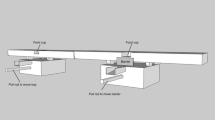Abstract
The present study aimed to investigate whether chimpanzees (Pan troglodytes) could learn a transverse pattern by being trained in the rules of the rock–paper–scissors game in which “paper” beats “rock,” “rock” beats “scissors,” and “scissors” beats “paper.” Additionally, this study compared the learning processes between chimpanzees and children. Seven chimpanzees were tested using a computer-controlled task. They were trained to choose the stronger of two options according to the game rules. The chimpanzees first engaged in the paper–rock sessions until they reached the learning criterion. Subsequently, they engaged in the rock–scissors and scissors–paper sessions, before progressing to sessions with all three pairs mixed. Five of the seven chimpanzees completed training after a mean of 307 sessions, which indicates that they learned the circular pattern. The chimpanzees required more scissors–paper sessions (14.29 ± 6.89), the third learnt pair, than paper–rock (1.71 ± 0.18) and rock–scissors (3.14 ± 0.70) sessions, suggesting they had difficulty finalizing the circularity. The chimpanzees then received generalization tests using new stimuli, which they learned quickly. A similar procedure was performed with children (35–71 months, n = 38) who needed the same number of trials for all three pairs during single-paired sessions. Their accuracy during the mixed-pair sessions improved with age and was better than chance from 50 months of age, which indicates that the ability to solve the transverse patterning problem might develop at around 4 years of age. The present findings show that chimpanzees were able to learn the task but had difficulties with circularity, whereas children learned the task more easily and developed the relevant ability at approximately 4 years of age. Furthermore, the chimpanzees’ performance during the mixed-pair sessions was similar to that of 4-year-old children during the corresponding stage of training.





Similar content being viewed by others
References
Alvarado MC, Rudy JW (1992) Some properties of configural learning: an investigation of the transverse-patterning problem. J Exp Psychol Anim B 18:145–153
Astur RS, Sutherland RJ (1998) Configural learning in humans: the transverse patterning problem. Psychobiology 26:176–182
Bates D, Maechler M, Bolker B, Walker S (2015) Fitting linear mixed-effects models using lme4. J Stat Softw 67:1–48. doi:10.18637/jss.v067.i01
Carlozzi NE, Thomas DG (2008) The utility of the transverse patterning task as a measure of configural learning in a college sample. Appl Neuropsychol 15:54–60
Carlson SM, Moses LJ (2001) Individual differences in inhibitory control and children’s theory of mind. Child Dev 72:1032–1053
Couvillon PA, Bitterman ME (1996) Transverse patterning in pigeons. Anim Learn Behav 24:410–422
Gerstadt CL, Hong YJ, Diamond A (1994) The relationship between cognition and action: performance of children 3.5–7 years old on a Stroop-like day–night test. Cognition 53:129–153
Gillan DJ (1981) Reasoning in the chimpanzee. II. Transitive inference. J Exp Psychol Anim B 7:150–164
Gross WL, Greene AJ (2007) Analogical inference: the role of awareness in abstract learning. Memory 15:838–844
Harlow HF (1949) The formation of learning sets. Psychol Rev 56:51–65
Harlow HF (1959) Learning set and error factor theory. In: Koch SE (ed) Psychology: a study of a science, vol 2. McGraw-Hill, New York, pp 492–537
Herrmann E, Call J, Hernández-Lloreda MV, Hare B, Tomasello M (2007) Humans have evolved specialized skills of social cognition: the cultural intelligence hypothesis. Science 317:1360–1366
Hull CL (1943) Principles of behavior: an introduction to behavior theory. Appleton-Century-Crofts, New York
Inoue S, Matsuzawa T (2007) Working memory of numerals in chimpanzees. Curr Biol 17:R1004–R1005
Kawai N, Matsuzawa T (2000) Cognition: numerical memory span in a chimpanzee. Nature 403:39–40
Matsuzawa T (1990) Form perception and visual acuity in a chimpanzee. Folia Primatol 55:24–32
Matsuzawa T (2001) Primate origins of human cognition and behavior. Springer, Tokyo
Matsuzawa T (2003) The Ai project: historical and ecological contexts. Anim Cogn 6:199–211
Matsuzawa T, Tomonaga M, Tanaka M (2006) Development in chimpanzees. Springer, Tokyo
Nejime M, Inoue M, Saruwatari M, Mikami A, Nakamura K, Miyachi S (2015) Responses of monkey prefrontal neurons during the execution of transverse patterning. Behav Brain Res 278:293–302
Ochiai T, Matsuzawa T (1997) Planting trees in an outdoor compound of chimpanzees for an enriched environment. In: Hare VL, Worley KE (eds) Proceedings of the Third International Conference on Environmental Enrichment. The shape of enrichment. San Diego, pp 355–364
R Core Team (2016) R: a language and environment for statistical computing. R Foundation for Statistical Computing, Vienna. URL https://www.R-project.org/. Accessed 26 June 2017
Rudy JW, Keith JR, Georgen K (1993) The effect of age on children’s learning of problems that require a configural association solution. Dev Psychobiol 26:171–184
Spence KW (1952) The nature of the response in discrimination learning. Psychol Rev 59:89
Thompson R (1953) Approach–avoidance in an ambivalent object discrimination problem. J Exp Psychol 45:341
Tomonaga M (2001) Investigating visual perception and cognition in chimpanzees (Pan troglodytes) through visual search and related tasks: from basic to complex processes. In: Matsuzawa T (ed) Primate origins of human cognition and behavior. Springer, Tokyo, pp 55–86
Vasconcelos M (2008) Transitive inference in non-human animals: an empirical and theoretical analysis. Behav Process 78:313–334
Vlamings PH, Hare B, Call J (2010) Reaching around barriers: the performance of the great apes and 3–5-year-old children. Anim Cogn 13:273–285
Wynne CDL (1996) Transverse patterning in pigeons. Behav Process 38:119–130
Acknowledgements
This study was supported by the Ministry of Education, Culture, Sports, Science and Technology of Japan (MEXT)/Japan Society for the Promotion of Science (JSPS) KAKENHI (Grant 16H06283 to T. M., and grant 15H05709 to M. T.); the MEXT National BioResource Project GAIN, the JSPS core-to-core CCSN and the JSPS-LGP-U04 to T. M. The authors would also like to thank the Xinfei Kindergarten in Xinxiang, Henan, China for their facilitation of the experiment with the children, and the staff of KUPRI for taking care of the chimpanzees. Our thanks are also due to Ikuma Adachi, Misato Hayashi, Fumito Kawakami, Etsuko Ichino, Akiho Muramatsu, Duncan Wilson, Yoshiki Kurosawa, Gabriela Melo Daly, Tomoko Takashima, and Akemi Hirakuri of KUPRI for their help with this study. We also thank Mr. Xia for the technical help with the early version of the program.
Author information
Authors and Affiliations
Corresponding author
Ethics declarations
Author contributions
J. G., Y. S., M. T., and T. M. designed the experiment; J. G., T. M., and M. T. collected the chimpanzee data; J. G. collected the child data; and J. G., Y. S., M. T., and T. M. wrote the manuscript.
Conflict of interest
The authors declare that they have no conflicts of interest.
Ethical approval
The research proposal for the chimpanzees was approved by the Animal Welfare and Animal Care Committee of KUPRI and by the Animal Research Committee of Kyoto University (Nos. 2015-044, 2016-064). All procedures adhered to the Japanese Act on the Welfare and Management of Animals. The research proposal for the experiment with children was approved by the Human Research Ethics Committee of KUPRI (No. 2016-011).
Electronic supplementary material
Below is the link to the electronic supplementary material.
About this article
Cite this article
Gao, J., Su, Y., Tomonaga, M. et al. Learning the rules of the rock–paper–scissors game: chimpanzees versus children. Primates 59, 7–17 (2018). https://doi.org/10.1007/s10329-017-0620-0
Received:
Accepted:
Published:
Issue Date:
DOI: https://doi.org/10.1007/s10329-017-0620-0




